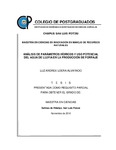| dc.contributor.advisor | Torres Aquino, Margarita | es_MX |
| dc.contributor.advisor | Cisneros Almazán, Rodolfo | es_MX |
| dc.contributor.author | Loera Alvarado, Luz Andrea | |
| dc.creator | LOERA ALVARADO, LUZ ANDREA; 701475 | |
| dc.date.accessioned | 2019-03-09T20:49:52Z | |
| dc.date.accessioned | 2019-01 | |
| dc.date.available | 2019-03-09T20:49:52Z | |
| dc.date.available | 2019-03 | |
| dc.date.issued | 2018-11 | |
| dc.date.submitted | 2018-11 | |
| dc.identifier.citation | Alvarado Loera, Luz Andrea (2018). Análisis de parámetros hídricos y uso potencial del agua de lluvia en la producción de forraje. Salinas de Hidalgo, S. L. P.: La autora, Tesis (Maestría en Ciencias, especialista en Innovación en el Manejo de Recursos Naturales), Colegio de Postgraduados, Campus San Luis Potosí, 2018 | es_MX |
| dc.identifier.uri | http://hdl.handle.net/10521/3131 | |
| dc.description.abstract | El agua es uno de los factores críticos en las zonas áridas y semiáridas para la producción agropecuaria, donde su escasez se agrava posiblemente debido al calentamiento global. En estas regiones una alternativa viable para enfrentar la situación del agua en época de estiaje es la captación del recurso en bordos de almacenamiento. El objetivo general de esta investigación fue determinar, con base en un estudio hidrológico, el funcionamiento de este tipo de obras; asimismo, evaluar la aptitud del agua cosechada para la producción de forraje. En primer término, se determinaron las características morfológicas de cada cuenca, se estimó el volumen de agua aprovechable en cada caso y se evaluó el estado actual de los bordos. Posteriormente, se recolectaron muestras del agua cosechada y se analizó su composición química, se analizó su calidad para definir su uso potencial para la irrigación de cultivos forrajeros. Finalmente, se estableció un módulo de producción de forraje mediante riego por goteo por gravedad y fertigación, donde se evaluó el rendimiento y calidad nutricional en maíz, triticale y pasto sudán. Los resultados del estudio hidrológico, evidencia fallas en el diseño y construcción de los bordos de almacenamiento. Se encontró que la composición química del agua cosechada es de buena calidad, apta para su uso en el riego agrícola. Finalmente, se obtuvo un rendimiento aceptable de forraje con buena calidad nutrimental. Se concluye que la cosecha de agua de lluvia en bordos de almacenamiento es una alternativa factible para enfrentar la escasez del recurso en las zonas semiáridas, contribuyendo a mejorar la producción de forraje en la época de estiaje. | es_MX |
| dc.description.abstract | Water is one of the critical factors in arid and semi-arid areas for agricultural production and livestock, where its scarcity is possibly aggravated by global warming. In these regions, a viable alternative to face the water situation during the dry season is the capture of the resource on earth dams. The general objective of this research was to determine, with based in a study hydrologic, the functioning of this type of dams; also, evaluate the suitability of the water harvested for forage production. In the first term, the morphological characteristics of each watershed were determined, the volume of usable water from in each case was estimated and the current state of the dams was evaluated. Afterwards, samples of harvested water were collected and their chemical composition was analyzed, their quality was analyzed to define their potential use for the irrigation of forage crops. Finally, a forage production module was established by drip irrigation by gravity and fertigation, where the yield and nutritional quality of maize, triticale and Sudan grass were evaluated. The results of the hydrologic study, evidence failures in the design and construction of the earth dams. It was found that the chemical composition of the water harvested is of good quality, suitable for use in agricultural irrigation. Finally, an acceptable yield of forage with good nutritional quality was obtained. It is concluded that the rainwater harvesting on earth dams is a feasible alternative to face the scarcity of the resource in the semi-arid zones, contributing to improve the forage production in the dry season. | es_MX |
| dc.description.sponsorship | Conacyt | es_MX |
| dc.format | pdf | es_MX |
| dc.format.extent | 4 Mb | |
| dc.language.iso | spa | es_MX |
| dc.publisher | La autora | es_MX |
| dc.rights | Acceso abierto | es_MX |
| dc.rights.uri | http://creativecommons.org/licenses/by-nc-nd/4.0 | es_MX |
| dc.subject | Research Subject Categories::FORESTRY, AGRICULTURAL SCIENCES and LANDSCAPE PLANNING::Plant production::Agronomy | es_MX |
| dc.subject.classification | CIENCIAS FÍSICO MATEMÁTICAS Y CIENCIAS DE LA TIERRA::CIENCIAS DE LA TIERRA Y DEL ESPACIO::HIDROLOGÍA::AGUAS SUPERFICIALES | es_MX |
| dc.subject.classification | CIENCIAS AGROPECUARIAS Y BIOTECNOLOGÍA::CIENCIAS AGRARIAS::AGRONOMÍA::CULTIVOS FORRAJEROS | es_MX |
| dc.subject.other | Maestría | es_MX |
| dc.subject.other | IMRN | es_MX |
| dc.subject.other | Agua de lluvia | es_MX |
| dc.subject.other | Análisis de agua | es_MX |
| dc.subject.other | Water analysis | |
| dc.subject.other | Water quality | en |
| dc.subject.other | Calidad del agua | es_MX |
| dc.subject.other | Forrajes | es_MX |
| dc.subject.other | forage | en |
| dc.subject.other | Plantas forrajeras | es_MX |
| dc.subject.other | Feed crops | en |
| dc.subject.other | Rendimiento del forraje | es_MX |
| dc.subject.other | Forage yield | en |
| dc.subject.other | Captación del agua de lluvia | es_MX |
| dc.subject.other | Rainwater harvesting | en |
| dc.title | Análisis de parámetros hídricos y uso potencial del agua de lluvia en la producción de forraje. | es_MX |
| dc.title.alternative | Analysis of water parameters and potential use of rainwater in forageproduction. | es_MX |
| dc.type | Tesis | es_MX |
| dc.type.conacyt | masterThesis | es_MX |
| dc.identificator | 1||25||2508||250814 | es_MX |
| dc.identificator | 6||31||3103||310307 | es_MX |
| dc.contributor.director | MARTINEZ MONTOYA, JUAN FELIPE;35144 | |
| dc.contributor.director | MARTINEZ HERNANDEZ, JOSE DE JESUS; 202683 | |
| dc.contributor.director | Martínez Montoya, Juan Felipe | es_MX |
| dc.audience | generalPublic | es_MX |


